Sunderland
Sunderland (/ˈsʌndərlənd/ (![]()
| Sunderland | |
|---|---|
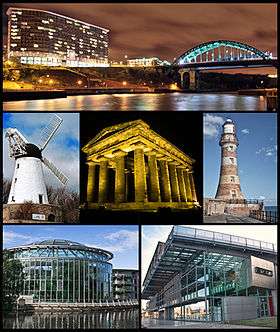 Clockwise, from top: Echo 24 and the Wearmouth Bridge, Roker Lighthouse, the National Glass Centre, Sunderland Museum and Winter Gardens, Fulwell Mill and Penshaw Monument | |
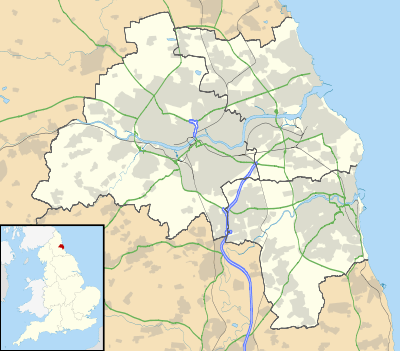 Sunderland Location within Tyne and Wear | |
| Population | 174,286 (2011 Census)[1] |
| Demonym | Mackem |
| OS grid reference | NZ395575 |
| • London | 240 mi (387 km) SSE |
| Metropolitan borough | |
| Metropolitan county | |
| Region | |
| Country | England |
| Sovereign state | United Kingdom |
| Post town | SUNDERLAND |
| Postcode district | SR1–SR6 |
| Dialling code | 0191 |
| Police | Northumbria |
| Fire | Tyne and Wear |
| Ambulance | North East |
| UK Parliament | |
Historically in County Durham, there were three original settlements by the mouth of the River Wear on the site of modern-day Sunderland. On the north side of the river, Monkwearmouth was settled in 674 when King Ecgfrith of Northumbria granted land to Benedict Biscop to found Monkwearmouth Monastery. In 685, Ecgfrith further granted Biscop the land adjacent to the monastery on the south side of the river. As the river separated this land from the monastic community, it was henceforth referred to as the "sunder-land", and would grow as a fishing settlement before being granted a charter in 1179.[5] West of the medieval village of Sunderland on the south bank, Bishopwearmouth was founded in 930.
Sunderland grew as a port, trading coal and salt. Ships began to be built on the river in the 14th century. By the 19th century, the port of Sunderland had absorbed Bishopwearmouth and Monkwearmouth, owing to the growing economic importance of the shipbuilding docks. Following the decline of the city's traditional industries in the late 20th century, the area grew into a commercial centre for the automotive industry, science and technology and the service sector.
Bede, sometimes called the father of English history, began his monastic career at Monkwearmouth monastery in Sunderland, before moving to the newly founded Jarrow monastery in 685 (these monasteries together formed the dual Monkwearmouth-Jarrow Abbey). It therefore seems likely that he was born in or near Sunderland. Indeed, Bede later wrote that he was "ácenned on sundorlande þæs ylcan mynstres" (born in a separate land of this same monastery); here, "sundorlande" translates literally as "separate land" but could refer to the village of Sunderland.[6][7] Alternatively, it is possible that Sunderland was later named in honour of Bede's connections to the area, by people familiar with this statement of his.
A person from Sunderland is sometimes known as a Mackem.[8][9][10] However, as this term originated as recently as the early 1980s, its use and acceptance by Sunderland residents, particularly among the older generations, is not universal.[11] At one time, Sunderland-built ships were called "Jamies", in contrast with those from Tyneside, which were known as "Geordies", although in the case of "Jamie" it is not known whether this was ever extended to people.[12]
History
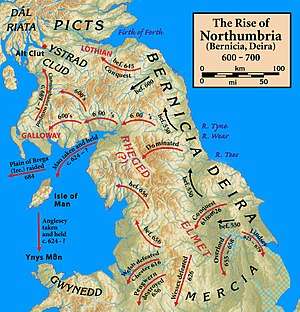
Early history
The earliest inhabitants of the Sunderland area were Stone Age hunter-gatherers and artifacts from this era have been discovered, including microliths found during excavations at St Peter's Church, Monkwearmouth.[13] During the final phase of the Stone Age, the Neolithic period (c. 4000 – c. 2000 BC), Hastings Hill, on the western outskirts of Sunderland, was a focal point of activity and a place of burial and ritual significance. Evidence includes the former presence of a cursus monument.[14]
It is believed the Brigantes inhabited the area around the River Wear in the pre- and post-Roman era. There is a long-standing local legend that there was a Roman settlement on the south bank of the River Wear on what is the site of the former Vaux Brewery, although no archaeological investigation has taken place.[15]
Early Middle Ages: Anglo-Saxon Northumbria
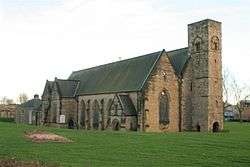
Recorded settlements at the mouth of the Wear date to 674, when an Anglo-Saxon nobleman, Benedict Biscop, granted land by King Ecgfrith of Northumbria, founded the Wearmouth–Jarrow (St. Peter's) monastery on the north bank of the river – an area that became known as Monkwearmouth. Biscop's monastery was the first built of stone in Northumbria. He employed glaziers from France and in doing so he re-established glass making in Britain.[16] In 686 the community was taken over by Ceolfrid, and Wearmouth–Jarrow became a major centre of learning and knowledge in Anglo-Saxon England with a library of around 300 volumes.[17]
The Codex Amiatinus, described by White as the 'finest book in the world',[18][19] was created at the monastery and was likely worked on by Bede, who was born at Wearmouth in 673.[20] This is one of the oldest monasteries still standing in England. While at the monastery, Bede completed the Historia ecclesiastica gentis Anglorum (The Ecclesiastical History of the English People) in 731, a feat which earned him the title The father of English history.[21]
In the late 8th century, the Vikings raided the coast, and by the middle of the 9th century, the monastery had been abandoned. Lands on the south side of the river were granted to the Bishop of Durham by Athelstan of England in 930; these became known as Bishopwearmouth and included settlements such as Ryhope which fall within the modern boundary of Sunderland.[22][23]
Medieval developments after the Norman conquest
In 1100, Bishopwearmouth parish included a fishing village at the southern mouth of the river (now the East End) known as 'Soender-land' (which evolved into 'Sunderland').[24] This settlement was granted a charter in 1179 by Hugh Pudsey, then the Bishop of Durham (who had quasi-monarchical power within the County Palatine);[25] the charter gave its merchants the same rights as those of Newcastle-upon-Tyne, but it nevertheless took time for Sunderland to develop as a port.[26] Fishing was the main commercial activity at the time: mainly herring in the 13th century, then salmon in the 14th and 15th centuries.[27] From 1346 ships were being built at Wearmouth, by a merchant named Thomas Menville,[28] and by 1396 a small amount of coal was being exported.[27]
Rapid growth of the port was initially prompted by the salt trade.[27] Salt exports from Sunderland are recorded from as early as the 13th century, but In 1589, salt pans were laid at Bishopwearmouth Panns (the modern-day name of the area the pans occupied is Pann's Bank, on the river bank between the city centre and the East End).[29] Large vats of seawater were heated using coal; as the water evaporated the salt remained. As coal was required to heat the salt pans, a coal mining community began to emerge. Only poor quality coal was used in salt panning; better quality coal was traded via the port, which subsequently began to grow.[30]
17th century
Both salt and coal continued to be exported through the 17th century, but the coal trade grew significantly (2-3,000 tons of coal were exported from Sunderland in the year 1600; by 1680 this had increased to 180,000 tons).[27] Because of the difficulty for colliers trying to navigate the shallow waters of the Wear, coal mined further inland was loaded onto keels (large, flat-bottomed boats) and taken downriver to the waiting colliers. The keels were manned by a close-knit group of workers known as 'keelmen'.[31]
In 1634 a charter was granted by Bishop Thomas Morton, which incorporated the inhabitants of the 'antient borough' of Sunderland as the 'Mayor, Aldermen and Commonality' of the Borough and granted the privilege of a market and an annual fair. While, as a consequence, a mayor and twelve aldermen were appointed, and a common council established, their establishment does not seem to have survived the ensuing Civil War.[32]
Before the 1st English civil war the North, with the exclusion of Kingston upon Hull, declared for the King. In 1644 the North was captured by parliament.[33] The villages that later become Sunderland, were taken in March 1644.[34] One artifact of the English civil war near this area was the long trench; a tactic of later warfare.[34] In the village of Offerton roughly three miles inland from the area, skirmishes occurred.[35][36] Parliament also blockaded the River Tyne, crippling the Newcastle coal trade which allowed the coal trade of the area to flourish for a short period.
In 1669, after the Restoration, King Charles II granted letters patent to one Edward Andrew, Esq. to 'build a pier and erect a lighthouse or lighthouses and cleanse the harbour of Sunderland', and authorised the levying of a tonnage duty on shipping in order to raise the necessary funds;[37] however it took time before these improvements were realized.
There is evidence of a growing number of shipbuilders or boatbuilders being active on the River Wear in the late 17th century: among others, the banking family Goodchilds opened a building yard in 1672 (it eventually closed when the bank went out of business in 1821); and in 1691 one Thomas Burn aged 17 is recorded as having taken over the running of a yard from his mother.[38]
18th century
.jpg)
River works
The River Wear Commission was formed in 1717 in response to the growing prosperity of Sunderland as a port.[39] Under the Board of Commissioners (a committee of local land owners, ship owners, colliery owners and merchants) a succession of civil engineers adapted the natural riverscape to meet the needs of maritime trade and shipbuilding. Their first major harbour work was the construction in stone of the South Pier (later known as the Old South Pier), begun in 1723 with the aim of diverting the river channel away from sandbanks;[40] the building of the South Pier continued until 1759. By 1748 the river was being manually dredged.[41] A northern counterpart to the South Pier was not yet in place; instead, a temporary breakwater was formed at around this time, consisting of a row of piles driven into the seabed interspersed with old keelboats. From 1786 work began on a more permanent North Pier (which was later known as the Old North Pier): it was formed from a wooden frame, filled with stones and faced with masonry, and eventually extended 1,500 ft (460 m) into the sea. The work was initially overseen by Robert Stout (the Wear Commissioners' Engineer from 1781 to 1795). In 1794 a lighthouse was built at the seaward end, by which time around half the pier had been enclosed in masonry;[40] it was completed in 1802.
By the start of the 18th century the banks of the Wear were described as being studded with small shipyards, as far as the tide flowed.[38] After 1717, measures having been taken to increase the depth of the river, Sunderland's shipbuilding trade grew substantially (in parallel with its coal exports).[42] A number of warships were built, alongside many commercial sailing ships. By the middle of the century the town was probably the premier shipbuilding centre in Britain.[43] By 1788 Sunderland was Britain's fourth largest port (by measure of tonnage) after London, Newcastle and Liverpool; among these it was the leading coal exporter (though it did not rival Newcastle in terms of home coal trade).[42] Still further growth was driven across the region, towards the end of the century, by London's insatiable demand for coal during the French Revolutionary Wars.[38]
Sunderland's third-biggest export, after coal and salt, was glass.[44] The town's first modern glassworks were established in the 1690s and the industry grew through the 17th century.[45] Its flourishing was aided by trading ships bringing good-quality sand (as ballast) from the Baltic and elsewhere which, together with locally available limestone (and coal to fire the furnaces) was a key ingredient in the glassmaking process. Other industries that developed alongside the river included lime burning and pottery making (the town's first commercial pottery manufactory, the Garrison Pottery, had opened in old Sunderland in 1750).[46]
.jpg)
The world's first steam dredger was built in Sunderland in 1796-7 and put to work on the river the following year.[41] Designed by Stout's successor as Engineer, Jonathan Pickernell jr (in post from 1795 to 1804), it consisted of a set of 'bag and spoon' dredgers driven by a tailor-made 4-horsepower Boulton & Watt beam engine. It was designed to dredge to a maximum depth of 10 ft (3.0 m) below the waterline and remained in operation until 1804, when its constituent parts were sold as separate lots.[41] Onshore, numerous small industries supported the business of the burgeoning port. In 1797 the world's first patent ropery (producing machine-made rope, rather than using a ropewalk) was built in Sunderland, using a steam-powered hemp-spinning machine which had been devised by a local schoolmaster, Richard Fothergill, in 1793;[44] the ropery building still stands, in the Deptford area of the city.[47]
Urban developments
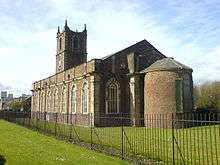
In 1719, the parish of Sunderland was carved from the densely populated east end of Bishopwearmouth by the establishment of a new parish church, Holy Trinity Church, Sunderland (today also known as Sunderland Old Parish Church). Later, in 1769, St John's Church was built as a chapel of ease within Holy Trinity parish; built by a local coal fitter, John Thornhill, it stood in Prospect Row to the north-east of the parish church. (St John's was demolished in 1972.)[48] By 1720 the port area was completely built up, with large houses and gardens facing the Town Moor and the sea, and labourers' dwellings vying with manufactories alongside the river.[27] The three original settlements of Wearmouth (Bishopwearmouth, Monkwearmouth and Sunderland) had begun to combine, driven by the success of the port of Sunderland and salt panning and shipbuilding along the banks of the river. Around this time, Sunderland was known as 'Sunderland-near-the-Sea'.[49]
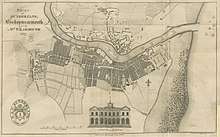
By 1770 Sunderland had spread westwards along its High Street to join up with Bishopwearmouth.[27] In 1796 Bishopwearmouth in turn gained a physical link with Monkwearmouth following the construction of a bridge, the Wearmouth Bridge, which was the world's second iron bridge (after the famous span at Ironbridge).[50] It was built at the instigation of Rowland Burdon, the Member of Parliament for County Durham, and described by Nikolaus Pevsner as being 'a triumph of the new metallurgy and engineering ingenuity [...] of superb elegance'.[27] Spanning the river in a single sweep of 236 feet (72 m), it was over twice the length of the earlier bridge at Ironbridge but only three-quarters the weight. At the time of building, it was the biggest single-span bridge in the world;[51] and because Sunderland had developed on a plateau above the river, it never suffered from the problem of interrupting the passage of high-masted vessels.
Defences
During the War of Jenkins' Ear a pair of gun batteries were built (in 1742 and 1745) on the shoreline to the south of the South Pier, to defend the river from attack (a further battery was built on the cliff top in Roker, ten years later).[52] One of the pair was washed away by the sea in 1780, but the other was expanded during the French Revolutionary Wars and became known as the Black Cat Battery.[53] In 1794 Sunderland Barracks were built, behind the battery, close to what was then the tip of the headland.[54]
19th century
_by_Stuart_Henry_Bell.jpg)
In 1802 a new, 72 ft (22 m) high octagonal stone lighthouse was built on the end of the newly finished North Pier, designed by the chief Engineer Jonathan Pickernell. At the same time he built a lighthouse on the South Pier, which showed a red light (or by day a red flag) when the tide was high enough for ships to pass into the river.[40] From 1820 Pickernell's lighthouse was lit by gas from its own gasometer.[32] In 1840 work began to extend the North Pier to 1,770 ft (540 m) and the following year its lighthouse was moved in one piece, on a wooden cradle, to its new seaward end, remaining lit each night throughout the process.[40]
Local government
.jpg)
In 1809 an Act of Parliament was passed creating an Improvement Commission, for 'paving, lighting, cleansing, watching and otherwise improving the town of Sunderland';[32] this provided the beginnings of a structure of local government for the township as a whole.[44] Commissioners were appointed, with the power to levy contributions towards the works detailed in the Act, and in 1812-14 the Exchange Building was built, funded by public subscription, to serve as a combined Town Hall, Watch House, Market Hall, Magistrate's Court, Post Office and News Room. It became a regular gathering place for merchants conducting business, and the public rooms on the first floor were available for public functions when not being used for meetings of the Commissioners. By 1830 the Commissioners had made a number of improvements, ranging from the establishment a police force to installing gas lighting across much of the town.[32]
In other aspects, however, Local government was still divided between the three parishes (Holy Trinity Church, Sunderland, St. Michael's, Bishopwearmouth, and St. Peter's, Monkwearmouth) and when cholera broke out in 1831, the "select vestrymen", as the church councilmen were called, were unable to cope with the epidemic.[55] Sunderland, a main trading port at the time, was the first British town to be struck with the 'Indian cholera' epidemic.[56] The first victim, William Sproat, died on 23 October 1831. Sunderland was put into quarantine, and the port was blockaded, but in December of that year the disease spread to Gateshead and from there, it rapidly made its way across the country, killing an estimated 32,000 people; among those to die was Sunderland's Naval hero Jack Crawford. (The novel The Dress Lodger by American author Sheri Holman is set in Sunderland during the epidemic.)[57]
Demands for democracy and organised town government saw the three parishes incorporated as the Borough of Sunderland in 1835.[58] Later, the Sunderland Borough Act of 1851 abolished the Improvement Commission and vested its powers in the new Corporation.[44]
Coal, staiths, railways and docks
.jpg)
In the early nineteenth century 'the three great proprietors of collieries upon the Wear [were] Lord Durham, the Marquis of Londonderry and the Hetton Company'.[32] In 1822 the Hetton colliery railway was opened, linking the company's collieries with staiths ('Hetton Staiths') on the riverside at Bishopwearmouth, where coal drops delivered the coal directly into waiting ships. Engineered by George Stephenson, it was the first railway in the world to be operated without animal power, and at the time (albeit briefly) was the longest railway in the world.[59] At the same time Lord Durham began establishing rail links to an adjacent set of staiths ('Lambton Staiths'). Lord Londonderry, on the other hand, continued conveying his coal downriver on keels; but he was working on establishing his own separate port down the coast at Seaham Harbour.
.jpg)
Although the volume of coal exports were increasing, there was a growing concern that without the establishment of a purpose-built dock Sunderland would start losing trade to Newcastle and Hartlepool.[61] The colliery rail links were on the south side of the river, but Sir Hedworth Williamson, who owned much of the land on the north bank, seized the initiative. He formed the Wearmouth Dock Company in 1832, obtained a Royal Charter for establishing a dock at Monkwearmouth riverside, and engaged no less a figure than Isambard Kingdom Brunel to provide designs (not only for docks but also for a double-deck suspension bridge to provide a rail link to the opposite side of the river). Building of the dock went ahead (albeit the smallest of Brunel's proposals) but not of the bridge; the resulting North Dock, opened in 1837, soon proved too small at 6 acres (2.4 ha), and it suffered through lack of a direct rail link to the colliery lines south of the Wear (instead, it would be linked, by way of the Brandling Junction Railway from 1839, to collieries in the Gateshead area).[61]
Also in Monkwearmouth, further upstream, work began in 1826 on sinking a pit in the hope of reaching the seams of coal (even though, at this location, they were deep underground). Seven years later, coal was struck at 180 fathoms;[62] digging deeper, the Bensham seam was found the following year at 267 fathoms and in 1835 Wearmouth Colliery, which was then the deepest mine in the world, began producing coal.[63] When the superior Hutton seam was reached, at a still greater depth in 1846, the mine (which had begun as a speculative enterprise by Messrs Pemberton and Thompson) began to be profitable.
.jpg)
Meanwhile, south of the river, the Durham & Sunderland Railway Co. built a railway line across the Town Moor and established a passenger terminus there in 1836. In 1847 the line was bought by George Hudson's York and Newcastle Railway. Hudson, nicknamed 'The Railway King', was Member of Parliament for Sunderland and was already involved in a scheme to build a dock in the area. In 1846 he had formed the Sunderland Dock Company, which received parliamentary approval for the construction of a dock between the South Pier and Hendon Bay.[64] The engineer overseeing the project was John Murray; the foundation stone for the entrance basin was laid in February 1848, and by the end of the year excavation of the new dock was largely complete, the spoil being used in the associated land reclamation works. Lined with limestone and entered from the river by way of a half tide basin, the dock (later named Hudson Dock) was formally opened by Hudson on 20 June 1850.[65] Most of the dockside to the west was occupied with coal staiths linked to the railway line, but there was also a warehouse and granary built at the northern end by John Dobson in 1856 (this, along with a second warehouse dating from the 1860s, was demolished in 1992).[66]
.jpg)
In 1850-56 a half-tidal sea-entrance was constructed at the south-east corner of the dock, protected by a pair of breakwaters, to allow larger ships to enter the dock direct from the North Sea. At the same time (1853–55) Hudson Dock itself was extended southwards and deepened, and, alongside the entrance basin to the north, the first of a pair of public graving docks was built.[65] In 1854 the Londonderry, Seaham & Sunderland Railway opened, linking the Londonderry and South Hetton collieries to a separate set of staiths at Hudson Dock South. It also provided a passenger service from Sunderland to Seaham Harbour.[67]
In 1859 the docks were purchased by the River Wear Commissioners. Under Thomas Meik as engineer the docks were further extended with the construction of Hendon Dock to the south (1864–67). (Hendon Dock was entered via Hudson Dock South, but in 1870 it too was provided with a half-tidal sea-entrance providing direct access from the North Sea.) Under Meik's successor, Henry Hay Wake, Hudson Dock was further enlarged and the entrances were improved:[65] in 1875 lock gates were installed (along with a swing bridge) at the river entrance, to allow entry at all states of the tide; they were powered by hydraulic machinery, installed by Sir William Armstrong in the adjacent dock office building.[68] Similarly, a new sea lock was constructed at the south-east entrance in 1877–80.[69] The breakwater (known as the 'Northeast Pier') which protected the sea entrance to the docks was provided with a lighthouse (29 ft (8.8 m) high and of lattice construction, since demolished) which Chance Brothers equipped with a fifth-order optic and clockwork occulting mechanism in 1888;[70] it displayed a sector light: white indicating the fairway and red indicating submerged hazards.[71]
By 1889 two million tons of coal per year was passing through the dock.[72] The eastern wharves, opposite the coal staiths, were mainly occupied by saw mills and timber yards, with large open spaces given over to the storage of pit props for use in the mines;[73] while to the south of Hendon Dock, the Wear Fuel Works distilled coal tar to produce pitch, oil and other products.[74]
After completion of the dock works, H. H. Wake embarked on the construction of Roker Pier (part of a scheme to protect the river approach by creating an outer harbour). Protection of a different kind was provided by the Wave Basin Battery, armed with four RML 80 pounder 5 ton guns, constructed just inside the Old South Pier in 1874.[75]
Increasing industrialisation had prompted affluent residents to move away from the old port area, with several settling in the suburban terraces of the Fawcett Estate and Mowbray Park. The area around Fawcett Street itself increasingly functioned as the civic and commercial town centre. In 1848 George Hudson's York, Newcastle and Berwick Railway built a passenger terminus, Monkwearmouth Station, just north of Wearmouth Bridge; and south of the river another passenger terminus, in Fawcett Street, in 1853. Later, Thomas Elliot Harrison (chief engineer to the North Eastern Railway) made plans to carry the railway across the river; the Wearmouth Railway Bridge (reputedly 'the largest Hog-Back iron girder bridge in the world') opened in 1879.[44] In 1886-90 a new Town Hall was built in Fawcett Street, just to the east of the railway station, designed by Brightwen Binyon.[27]
"The greatest shipbuilding port in the world"
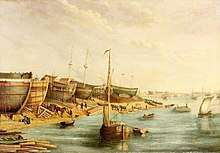
Sunderland's shipbuilding industry continued to grow through most of the 19th century, becoming the town's dominant industry and a defining part of its identity.[44] By 1815 it was 'the leading shipbuilding port for wooden trading vessels' with 600 ships constructed that year across 31 different yards.[77] By 1840 the town had 76 shipyards and between 1820 and 1850 the number of ships being built on the Wear increased fivefold. From 1846 to 1854 almost a third of the UK's ships were built in Sunderland, and in 1850 the Sunderland Herald proclaimed the town to be the greatest shipbuilding port in the world.[78]
During the century the size of ships being built increased and technologies evolved: in 1852 the first iron ship was launched on Wearside, built by marine engineer George Clark in partnership with shipbuilder John Barkes.[79] Thirty years later Sunderland's ships were being built in steel[44] (the last wooden ship having been launched in 1880).[77] As the century progressed, the shipyards on the Wear decreased in number on the one hand, but increased in size on the other, so as to accommodate the increasing scale and complexity of ships being built.[77]
Shipyards founded in the 19th century, and still operational in the 20th, included:[76]
- Sir James Laing & Sons (established by Philip Laing at Deptford in 1818, renamed Sir James Laing & sons in 1898)
- S. P. Austin (established in 1826 at Monkwearmouth, moving across the river to a site alongside Wearmouth Bridge in 1866)
- Bartram & Sons (established at Hylton in 1837, moved to South Dock in 1871)
- William Doxford & Sons (established at Cox Green in 1840, moved to Pallion in 1857)
- William Pickersgill's (established at Southwick in 1845)
- J. L. Thompson & Sons (yard established at North Sands by Robert Thompson in 1846, taken over by his son Joseph in 1860, another son (also Robert) having established his own yard at Southwick in 1854)
- John Crown & Sons (yard established at Monkwearmouth by Luke Crown (or Crone) by 1807, taken over by his grandson Jackie in 1854)
- Short Brothers (established by George Short in 1850, moved to Pallion in 1866)
- Sir J Priestman (established at Southwick in 1882)
Alongside the shipyards, marine engineering works were established from the 1820s onwards, initially providing engines for paddle steamers; in 1845 a ship named Experiment was the first of many to be converted to steam screw propulsion.[38] Demand for steam-powered vessels increased during the Crimean War; nonetheless, sailing ships continued to be built, including fast fully-rigged composite-built clippers, including the City of Adelaide in 1864 and Torrens (the last such vessel ever built), in 1875.[76]
Other industries
.jpg)
By the middle of the century glassmaking was at its height on Wearside. James Hartley & Co., established in Sunderland in 1836, grew to be the largest glassworks in the country and (having patented an innovative production technique for rolled plate glass) produced much of the glass used in the construction of the Crystal Palace in 1851.[46] A third of all UK-manufactured plate glass was produced at Hartley's by this time.[44] Other manufacturers included the Cornhill Flint Glassworks (established at Southwick in 1865), which went on to specialise in pressed glass, as did the Wear Flint Glassworks (which had originally been established in 1697).[45] In addition to the plate glass and pressed glass manufacturers there were 16 bottle works on the Wear in the 1850s, with the capacity to produce between 60 and 70,000 bottles a day.[46]
Local potteries also flourished in the mid-19th century, again making use of raw materials (white clay and stone) being brought into Sunderland as ballast on ships. Sunderland pottery was exported across Europe, with Sunderland Lustreware proving particularly popular in the home market; however the industry sharply declined later in the century due to foreign competition, and the largest remaining manufacturer (Southwick Pottery) closed in 1897.[46]
Victoria Hall Disaster
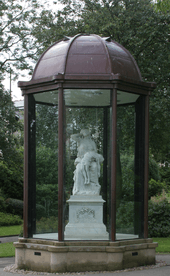
Victoria Hall was a large concert hall on Toward Road facing Mowbray Park. The hall was the scene of a tragedy on 16 June 1883 when 183 children died.[80] During a variety show, children rushed towards a staircase for treats.[81] At the bottom of the staircase, the door had been opened inward and bolted in such a way as to leave only a gap wide enough for one child to pass at a time.[82] The children surged down the stairs and those at the front were trapped and crushed by the weight of the crowd behind them.[83]
The asphyxiation of 183 children aged between three and 14 is the worst disaster of its kind in British history.[84] The memorial, a grieving mother holding a dead child, is located in Mowbray Park inside a protective canopy.[85] Newspaper reports triggered a mood of national outrage and an inquiry recommended that public venues be fitted with a minimum number of outward opening emergency exits, which led to the invention of 'push bar' emergency doors. This law remains in force. Victoria Hall remained in use until 1941 when it was destroyed by a German bomb.[86]
20th and 21st centuries
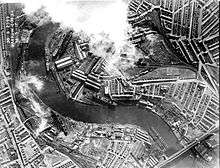
The public transport network was enhanced in 1900 - 1919 with an electric tram system. The trams were gradually replaced by buses during the 1940s before being completely axed in 1954.[87] In 1909 the Queen Alexandra Bridge was built, linking Deptford and Southwick.[88]
.jpg)
The First World War led to a notable increase in shipbuilding but also resulted in the town being targeted by a Zeppelin raid in 1916. The Monkwearmouth area was struck on 1 April 1916 and 22 lives were lost. Many citizens also served in the armed forces during this period, over 25,000 men from a population of 151,000.[89]
In the wake of the First World War, and on through the Great Depression of the 1930s, shipbuilding dramatically declined: the number of shipyards on the Wear went from fifteen in 1921 to six in 1937.[77] The small yards of J. Blumer & Son (at North Dock) and the Sunderland Shipbuilding Co. Ltd. (at Hudson Dock) both closed in the 1920s, and other yards were closed down by National Shipbuilders Securities in the 1930s (including Osbourne, Graham & Co., way upriver at North Hylton, Robert Thompson & Sons at Southwick, and the 'overflow' yards operated by Swan, Hunter & Wigham Richardson and William Gray & Co.).[90]
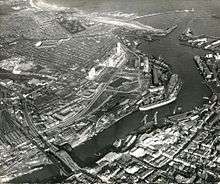
With the outbreak of World War II in 1939, Sunderland was a key target of the German Luftwaffe, who claimed the lives of 267 people[91] in the town, caused damage or destruction to 4,000 homes, and devastated local industry. After the war, more housing was developed. The town's boundaries expanded in 1967 when neighbouring Ryhope, Silksworth, Herrington, South Hylton and Castletown were incorporated into Sunderland.
During the second half of the 20th century shipbuilding and coalmining declined; shipbuilding ended in 1988 and coalmining in 1993. At the worst of the unemployment crisis up to 20% of the local workforce were unemployed in the mid-1980s.[92]
As the former heavy industries declined, new industries were developed (including electronic, chemical, paper and motor manufacture) and the service sector expanded during the 1980s and 1990s.[93] In 1986 Japanese car manufacturer Nissan opened its Nissan Motor Manufacturing UK factory in Washington, which has since gone on to become the UK's largest car factory.[94]
From 1990, the banks of the Wear were regenerated with the creation of housing, retail parks and business centres on former shipbuilding sites. Alongside the creation of the National Glass Centre the University of Sunderland has built a new campus on the St. Peter's site. The clearance of the Vaux Breweries site on the north west fringe of the city centre created a further opportunity for development in the city centre.[95][96][97]
Sunderland received city status in 1992.[98] Like many cities, Sunderland comprises a number of areas with their own distinct histories, Fulwell, Monkwearmouth, Roker, and Southwick on the northern side of the Wear, and Bishopwearmouth and Hendon to the south. On 24 March 2004, the city adopted St. Benedict Biscop as its patron saint.[99]
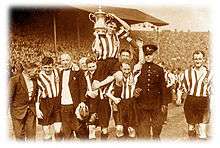
The 20th century saw Sunderland A.F.C. established as the Wearside area's greatest claim to sporting fame. Founded in 1879 as Sunderland and District Teachers A.F.C. by schoolmaster James Allan, Sunderland joined The Football League for the 1890–91 season. By 1936 the club had been league champions on five occasions. They won their first FA Cup in 1937, but their only post-World War II major honour came in 1973 when they won a second FA Cup. They have had a checkered history and dropped into the old third division for a season and been relegated thrice from the Premier League, twice with the lowest points ever,[100] earning the club a reputation as a yo-yo club. After 99 years at the historic Roker Park stadium,[101] the club moved to the 42,000-seat Stadium of Light on the banks of the River Wear in 1997. At the time, it was the largest stadium built by an English football club since the 1920s, and has since been expanded to hold nearly 50,000 seated spectators.[102]
Many fine old buildings remain despite the bombing that occurred during World War II.[103] Religious buildings include Holy Trinity Church, built in 1719 for an independent Sunderland, St. Michael's Church, built as Bishopwearmouth Parish Church and now known as Sunderland Minster and St. Peter's Church, Monkwearmouth, part of which dates from AD 674, and was the original monastery. St. Andrew's Roker, known as the "Cathedral of the Arts and Crafts Movement", contains work by William Morris, Ernest Gimson and Eric Gill.[104] St Mary's Catholic Church is the earliest surviving Gothic revival church in the city.[105]
Governance
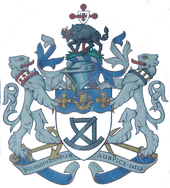
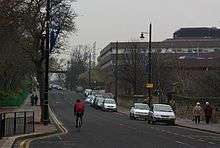
Sunderland was created a municipal borough of County Durham in 1835. Under the Local Government Act 1888, it was given the status of a County Borough, independent from county council control. In 1974, under the Local Government Act 1972, the county borough was abolished and its area combined with that of other districts to form the Metropolitan Borough of Sunderland in Tyne and Wear. In 1986, Tyne and Wear County Council was abolished, and Sunderland became a unitary authority, once again independent from county council control. The metropolitan borough was granted city status after winning a competition in 1992 to celebrate the Queen's 40th year on the throne. The population of the city taken at the 2011 Census was 275,506.[106]
Although it is a unitary authority, many public services in the City of Sunderland are provided in cooperation with neighbouring local authorities. For instance, the Northumbria Police covers the five (now independent) boroughs of Tyne and Wear, plus the neighbouring county of Northumberland. The Tyne and Wear Fire and Rescue Service covers the five boroughs only.
Since 2014, the City of Sunderland has been a member of the North East Combined Authority, which is an alliance of the five former boroughs of Tyne and Wear and the neighbouring counties of Northumberland and County Durham. However, Sunderland is still a unitary authority; combined authorities are voluntary alliances, in which local authorities agree to pool certain responsibilities and receive delegated functions from central government. For instance, the Tyne and Wear Passenger Transport Executive, better known by its brand name Nexus, is now an executive body of the North East Combined Authority.
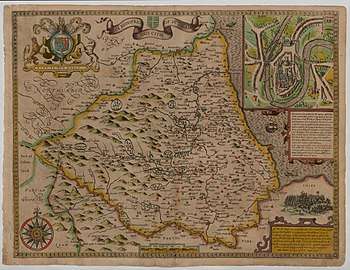
| Years | Title | Parent or alliance |
|---|---|---|
| 674 - 866 | Monkwearmouth (or Wearmouth) | Kingdom of Northumbria[107][108] |
| 883 - 930 | Monkwearmouth (or Wearmouth) | Liberty of Saint Cuthbert's Land[109] |
| 930 - 995 | Monkwearmouth and Bishopwearmouth | Liberty of Saint Cuthbert's Land |
| 995 - 1179 | Monkwearmouth and Bishopwearmouth | Liberty of Durham[110] |
| 1179 - 1293 | Sunderland | Liberty of Durham |
| 1293 - 1835 | Sunderland | County Palatine of Durham |
| 1835 - 1888 | Municipal Borough of Sunderland | County Durham[111] |
| 1888 - 1974 | County Borough of Sunderland | County Durham |
| 1974 - 1992 | Metropolitan Borough of Sunderland | Tyne and Wear |
| 1992 - 2014 | City of Sunderland | Tyne and Wear |
| 2014–present | City of Sunderland | North East Combined Authority (an alliance) |
Sunderland has the motto of Nil Desperandum Auspice Deo or Under God's guidance we may never despair[112]
Geography
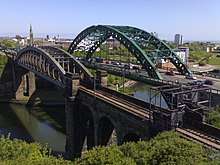
Much of the city is located on a low range of hills running parallel to the coast. On average, it is around 80 metres above sea level. Sunderland is divided by the River Wear which passes through the middle of the city in a deeply incised valley, part of which is known as the Hylton gorge. The three road bridges connecting the north and south portions of the city are the Queen Alexandra Bridge at Pallion, the Wearmouth Bridge just to the north of the city centre and most recently the Northern Spire Bridge between Castletown and Pallion. To the west of the city, the Hylton Viaduct carries the A19 dual-carriageway over the Wear (see map below).
Most of the suburbs of Sunderland are situated towards the west of the city centre with 70% of its population living on the south side of the river and 30% on the north side. The city extends to the seafront at Hendon and Ryhope in the south and Seaburn in the north.
Suburbs
Some, mainly local authority-built, Sunderland suburbs have most streets beginning with the same letter:
- A: Farringdon
- B: Town End Farm and Barnes
- C: Hylton Castle
- D: Dykelands Road area of Seaburn
- E: Carley Hill
- F: Ford Estate
- G: Grindon
- H: Hylton Lane / Havelock / Humbledon
- J: John Street, Sunderland
- K: Downhill
- M: Moorside and Millfield, Tyne and Wear
- P: Pennywell and Plains Farm and Pallion
- R: Red House
- S: Springwell, Southwick
- T: Thorney Close
- W: Witherwack
In Marley Pots, the streets are all associated with trees, e.g. Maplewood, Elmwood etc. In Millfield, the streets are all associated with plants, e.g. Chester, Fern, Rose, Hyacinth etc.
Definitions of Sunderland
There are two definitions for Sunderland. The smaller Urban Subdivision follows the boundaries of what is considered the city itself, however, the USD alone has not been given city status. The larger metropolitan borough contains other settlements with a separate identity such as Washington, but has been given official city status, with all individual settlements being the responsibility of Sunderland city council.
Green belt
The town is bounded by the Tyne & Wear Green Belt,[113] with its portion in much of its surrounding rural area of the borough. It is a part of the local development plan, of which its stated aims[113] are as follows:
A Green Belt will be maintained which will:-
(i) Check the unrestricted sprawl of the built up area of Sunderland;
(ii) Assist in safeguarding the city’s countryside from further encroachment;
(iii) Assist in the regeneration of the urban area of the city;
(iv) Preserve the setting and special character of Springwell Village;
(iv) Prevent the merging of Sunderland with Tyneside, Washington, Houghton-le-Spring and Seaham, and the merging of Shiney Row with Washington, Chester-le-Street and Bournmoor.
In the Sunderland borough boundary, as well as the aforementioned areas, landscape features and facilities such as much of the River Don and Wear basins, the George Washington Hotel Golf and Spa complex, Sharpley Golf Course, Herrington Country Park, Houghton Quarry and Penshaw Hill are within the green belt area.
Climate
Sunderland has a temperate oceanic climate (Köppen: Cfb). Its location in the rain shadow of the Pennines, as well as other mountain ranges to the west, such as those of the Lake District and southwestern Scotland, make Sunderland one of the least rainy cities of Northern England. The climate is heavily moderated by the adjacent North Sea, giving it cool summers, and winters that are mild considering its latitude. The closest weather station is in Tynemouth, about 8 miles (13 km) north of Sunderland. As a result, Sunderland's coastline is likely slightly milder given the more southerly position. Another relatively nearby weather station in Durham has warmer summer days and colder winter nights courtesy of its inland position.
| Climate data for Tynemouth, 1981–2010 | |||||||||||||
|---|---|---|---|---|---|---|---|---|---|---|---|---|---|
| Month | Jan | Feb | Mar | Apr | May | Jun | Jul | Aug | Sep | Oct | Nov | Dec | Year |
| Average high °C (°F) | 7.2 (45.0) |
7.3 (45.1) |
9.0 (48.2) |
10.3 (50.5) |
12.7 (54.9) |
15.6 (60.1) |
18.1 (64.6) |
18.1 (64.6) |
16.1 (61.0) |
13.2 (55.8) |
9.7 (49.5) |
7.4 (45.3) |
12.1 (53.8) |
| Average low °C (°F) | 2.2 (36.0) |
2.2 (36.0) |
3.3 (37.9) |
4.8 (40.6) |
7.2 (45.0) |
10.0 (50.0) |
12.3 (54.1) |
12.3 (54.1) |
10.4 (50.7) |
7.7 (45.9) |
4.9 (40.8) |
2.5 (36.5) |
6.7 (44.1) |
| Average precipitation mm (inches) | 45.5 (1.79) |
37.8 (1.49) |
43.9 (1.73) |
45.4 (1.79) |
43.2 (1.70) |
51.9 (2.04) |
47.6 (1.87) |
59.6 (2.35) |
53.0 (2.09) |
53.6 (2.11) |
62.8 (2.47) |
52.9 (2.08) |
597.2 (23.51) |
| Average precipitation days (≥ 1.0 mm) | 9.8 | 7.6 | 8.7 | 8.2 | 8.3 | 8.7 | 8.6 | 9.2 | 8.1 | 10.7 | 11.6 | 10.1 | 109.5 |
| Mean monthly sunshine hours | 61.1 | 81.6 | 117.7 | 149.9 | 191.7 | 183.0 | 185.7 | 174.9 | 141.1 | 106.2 | 70.4 | 51.9 | 1,515 |
| Source: Met Office[114] | |||||||||||||
Demography
| Population of Sunderland urban area by ward[115] | |
| Ward | Population |
| Castle | 11,292 |
| Fulwell | 12,906 |
| Redhill | 11,867 |
| St Peter's | 11,760 |
| Southwick | 11,634 |
| Northside total: | 59,459 |
| Barnes | 12,030 |
| Doxford | 11,318 |
| Hendon | 11,551 |
| Millfield | 10,277 |
| Pallion | 10,385 |
| Ryhope | 11,217 |
| St Anne's | 11,409 |
| St Chad's | 10,922 |
| St Michael's | 11,626 |
| Sandhill | 11,319 |
| Silksworth | 11,245 |
| Southside total: | 123,299 |
| City total: | 182,758 |
At 3,874 hectares, Sunderland is the 45th largest urban area in England by measure of area, with a population density of 45.88 people per hectare.
According to statistics[116] based on the 2001 census, 60% of homes in the Sunderland metropolitan area are owner occupied, with an average household size of 2.4 people. Three percent of the homes have no permanent residents.
The most ethnically diverse ward of the city was the (now defunct)[117] Thornholme area which had a population of 10,214 in 2001. This ward, which included Eden Vale, Thornhill, as well as parts of Hendon, Ashbrooke and the city centre, has long been the focus of Wearside's Bangladeshi community. In Thornholme, 89.4% are white (86.3% White British), 7.8% are Asian and 1.3% are mixed-race.[118] Today, the Barnes ward, which contains part of former Thornholme ward, has the highest percentage (5.4%) of Bangladeshi residents in the city, with people of this ethnicity being the ward's only significant ethnic minority. The 2001 census also recorded a substantial concentration of Greek nationals, living mainly in Central and Thornholme wards. The least ethnically diverse wards are in the north of the city. The area of Castletown is made up of 99.3% white, 0.4% Asian and 0.2% mixed-race.
The Sunderland USD had a population of 174,286 in 2011 compared with 275,506 for the wider city. Both of these figures are a decrease compared with 2001 figures that showed the Sunderland USD had a population of 182,758 compared with 280,807 for the wider city.[119]
In 2011, the Millfield ward, which contains the western half of the city centre, was the most ethnically diverse ward in Sunderland. Millfield is a multiracial area with large Indian and Bangladeshi communities, being the centre of Wearside's Bangladeshi community along with neighbouring Barnes. The ward's ethnicity was, in 2011, 76.4% White (73.5% White British), 17.6% Asian and 2.5% Black.[120] Other wards with high ethnic minority populations include Hendon, Barnes, St Michael's and St Peter's. In 2011, the least ethnically diverse ward was the Northside suburb Redhill which was 99.0% White (98.3% White British), 0.3% Asian and 0.1% Black.[121] This ward has so few ethnic minorities that it can even be compared to rural wards in Cumbria and it also proves there is a lot of contrast between areas when it comes to ethnicity.
Here is a table comparing Sunderland and the wider City of Sunderland Metropolitan Borough as well as North East England.
| 2011 Census Ethnic Groups | White British | Asian | Black |
|---|---|---|---|
| Sunderland (Urban Subdivision) | 93.4% | 3.6% | 0.6% |
| Metropolitan Borough of Sunderland | 94.8% | 2.6% | 0.5% |
| North East England | 93.6% | 2.8% | 0.5% |
The Sunderland Urban Subdivision is made up of all the wards listed on the table on the right hand side. In the Sunderland Urban Subdivision, 6.6% of the population were from an ethnic minority group (non white British) compared with 5.2% in the surrounding borough. Sunderland is less ethnically diverse than Gateshead and South Shields, mainly because of many outlying suburbs to the south, north and west of the city such as St Chad's, Southwick and Fulwell which have very high White British populations. The Sunderland Central Parliament constituency largely omits these areas. However, in 2001, the Sunderland USD was 96.6% White British, so the ethnic minority population is increasing.
Religion
The area is part of the Anglican Diocese of Durham. It has been in the Roman Catholic Diocese of Hexham and Newcastle[124] since the Catholic hierarchy was restored in 1850. The 2011 census recorded that 70.2% of the population identified as Christian, 1.32% as Muslim, 0.29% as Sikh, 0.22% as Hindu, 0.19% as Buddhist, 0.02% as Jewish, and 21.90% as having no religion.[125]
Jewish heritage in the city, once part of a thriving community, can be dated back to around 1750, when a number of Jewish merchants from across the UK and Europe settled in Sunderland,[126] eventually forming a congregation in 1768. A rabbi from Holland was established in the city in 1790. After a rapid growth in numbers during the latter half of the nineteenth century, the Jewish community in Sunderland reached its height in the mid 1930s, when around 2,000 Jews were recorded to be living in the town.[127] The community has been in slow decline since the mid-20th century. Many Sunderland Jews left for stronger Jewish communities in Britain or to Israel.[128] The Jewish primary school, the Menorah School, closed in July 1983. The synagogue on Ryhope Road, opened in 1928, closed at the end of March 2006.[129] (See also Jews and Judaism in North East England) The Jewish population of the Sunderland Metropolitan Borough is continually diminishing, as the Jewish population fell from 114 people in 2001, to 76 people in 2011.[130]
In 1998, following the grant of City status to Sunderland, the erstwhile parish church of Bishopwearmouth (St Michael's) was redesignated as Sunderland Minster with a city-wide role. It was believed to have been the first creation of a minster church in England since the Reformation.[44]
Alexander Boddy and the Early Development of Pentecostalism in Britain
The Reverend Alexander Boddy (who lived 1854-1930) was appointed vicar of All Saints Church (Church of England) in the Monkwearmouth area of Sunderland in 1884. During his ministry at Monkwearmouth, Boddy was influenced by the 1904-1905 Welsh revival and also by the British-born Norwegian preacher Thomas Ball Barratt (T.B. Barratt). In the early years of the 20th century All Saints, Monkwearmouth became an important centre for the development of the Pentecostal Movement in Britain.
Economy
Regeneration
Since the mid-1980s Sunderland has undergone massive regeneration , particularly around the central business district and the river corridor, following the industrial decline of the 1970s and early 1980s.
In the mid-1980s, Sunderland's economic situation began to improve following the collapse of the local shipbuilding industry. Japanese car manufacturer Nissan opened the Nissan Motor Manufacturing UK factory in 1986, and the first Nissan Bluebird car was produced later that year.[94] The factory and its supplier companies remain the largest employers in the region, with current cars produced there including the Nissan Qashqai, the Nissan Juke and the electric Nissan LEAF. As of 2012 over 500,000 cars are produced annually, and it is the UK's largest car factory.[94]
Also in the late 1980s, new service industries moved into sites such as the Doxford International Business Park in the south west of the city, attracting national and international companies. Sunderland was named in the shortlist of the top seven "intelligent cities" in the world for the use of information technology, in 2004 and 2005.[131]
The former shipyards along the Wear were transformed with a mixture of residential, commercial and leisure facilities including St. Peter's Campus of the University of Sunderland, University accommodation along the Fish Quay on the South side of the river, the North Haven housing and marina development, the National Glass Centre, the Stadium of Light and Hylton Riverside Retail Park. Also in 2007, the Echo 24 luxury apartments opened on Pann's Bank overlooking the river. In 2008 the Sunderland Aquatic Centre opened adjacent to the Stadium of Light, containing the only Olympic-size swimming pool between Leeds and Edinburgh. In 2000, the Bridges shopping centre was extended towards Crowtree Road and the former Central Bus Station, attracting national chain stores. This was followed by adjacent redevelopments on Park Lane.
Sunderland Corporation's massive post-war housing estate developments at Farringdon, Pennywell and Grindon have all passed into the ownership of Gentoo (previously 'Sunderland Housing Group'), a private company and a Registered Social Landlord.
Sunderland A.F.C. has been a major symbol of the area and a contributor to the local economy since the late 19th century. The club was one of the most successful and best supported clubs in the English game during this era, with its home at Roker Park holding more than 70,000 spectators at its peak. However, the FA Cup triumph of 1973 would prove to be the club's only postwar major trophy to date, and after its relegation in 1958 the club frequently bounced between the top two divisions of English football, and in 1987 and again in 2018 suffered relegation to the third tier of English football. The club played at Roker Park for 99 years until the completion of the new Stadium of Light at Monkwearmouth on the banks of the River Wear in 1997. The new stadium seated more than 42,000 on its completion, and has since been expanded to hold some 49,000 spectators. Sunderland's relatively high attendances have been a major boost to the local economy - averaging at more than 30,000 even during the club's current spell in the third tier of English football.
In 2004, redevelopment work began in the Sunniside area in the east-end of the city centre, including a multiplex cinema, a multi-storey car park, restaurants, a casino and tenpin bowling. Originally the River Quarter, the site was renamed Limelight in 2005, and renamed in 2008, when it became Sunniside Leisure. Sunniside Gardens were landscaped, and a number of new cafes, bars and restaurants were opened. Up-market residential apartments were developed, including the Echo 24 building.[132]
Sunderland City Council's Unitary Development Plan (UDP) outlines ambitious regeneration plans for a number of sites around the city.[133] The plans are supported by Sunderland Arc, an urban regeneration company funded by the City council, One NorthEast and the Homes and Communities Agency.
- Vaux and Farringdon Row
Since the closure of the Vaux brewery in 1999, a 26-acre (11-hectare) brownfield site has lain dormant in the centre of Sunderland. The land is subject to dispute between supermarket chain Tesco, who bought the site in 2001, and Sunderland arc, who submitted plans for its redevelopment in 2002.[134] During formal negotiations, Tesco stated they would be willing to sell the land to arc, if an alternative city centre site could be found. Possibilities include Holmeside Triangle, and the Sunderland Retail Park in Roker. Arc hope to begin development in 2010.[134] Arc's plans for the site were approved by the Secretary of State in 2007, and include extensive office space, hotels, leisure and retail units, residential apartments and a new £50 m Crown and Magistrates court. The central public arcade will be located under an expansive glass canopy. It is hoped an "evening economy" can be encouraged which will complement the city's nightlife.[135] In 2013 in the area opposite the Vaux site, Sunderland City Council announced the Keel Square project, a new public space designed to commemorate Sunderand's maritime heritage, which was completed in May 2015.[136] Construction commenced in 2014.
- Stadium Village
Redevelopment of the Monkwearmouth Colliery site, which sits on the north bank of the river Wear opposite the Vaux site, began in the mid-1990s with the creation of the Stadium of Light. In 2008, it was joined by the Sunderland Aquatic Centre. The Sheepfolds industrial estate occupies a large area of land between the Stadium and the Wearmouth Bridge. Sunderland Arc were in the process of purchasing land in the Sheepfolds, with a view to relocate the businesses and redevelop the site. The emphasis of development plans included further sporting facilities, in order to create a Sports Village. Other plans included a hotel, residential accommodation, and a footbridge linking the site with the Vaux development.[137]
- Grove and Transport Corridor
The Sunderland Strategic Transport Corridor (SSTC) is a proposed transport link from the A19, through the city centre, to the port. A major phase of the plan was the creation of a new bridge, the Northern Spire Bridge, which links the A1231 Wessington Way on the north of the river with the Grove site in Pallion, on the south of the river. In 2008, Sunderland City Council offered the residents of Sunderland the opportunity to vote on the design of the bridge. The choices were a 180-metre (590 ft) iconic cable-stayed bridge, which would result in a temporary increase in council tax, or a simple box structure which would be within the council's budget.[138] The results of the consultation were inconclusive, with residents keen to have an iconic bridge, but reluctant to have a subsequent increase in tax to fund it.[139] Regardless of the ultimate design of the new bridge, the landing point will be the former Grove Cranes site in Pallion. Plans for this site focus around the creation of a new residential area, with homes, community buildings, commercial and retail space.[140]
- The Port
The Port of Sunderland, owned by the city council, has been earmarked for medium-term redevelopment with a focus on mixed-use industry.[141]
Ship building and coal mining
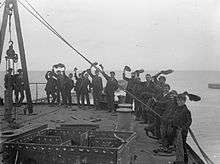
.jpg)
Once hailed as the "Largest Shipbuilding Town in the World",[142] ships were built on the Wear from at least 1346[143] onwards and by the mid-18th century Sunderland was one of the chief shipbuilding towns in the country. Sunderland Docks was the home of operations for the shipbuilding industry on Wearside. The Port of Sunderland was significantly expanded in the 1850s with the construction of Hudson Dock to designs by River Wear Commissioner's Engineer John Murray, with consultancy by Robert Stephenson.[144] One famous vessel was the Torrens, the clipper in which Joseph Conrad sailed,[145] and on which he began his first novel. She was one of the most famous ships of her time and can claim to be the finest ship ever launched from a Sunderland yard.
.jpg)
Between 1939 and 1945 the Wear yards launched 245 merchant ships totalling 1.5 million tons, a quarter of the merchant tonnage produced in the UK at this period.[146] Competition from overseas caused a downturn in demand for Sunderland built ships toward the end of the 20th century. The last shipyard in Sunderland closed on 7 December 1988.[147]
Sunderland, part of the Durham coalfield, has a coal-mining heritage that dates back centuries. At its peak in 1923, 170,000 miners were employed in County Durham alone,[148] as labourers from all over Britain, including many from Scotland and Ireland, entered the region. As demand for coal slipped following World War II, mines began to close across the region, causing mass unemployment. The last coal mine closed in 1994.[149] The site of the last coal mine, Wearmouth Colliery, is now occupied by the Stadium of Light, and a miner's Davy lamp monument stands outside of the ground to honour the site's mining heritage. Documentation relating to the region's coalmining heritage are stored at the North East England Mining Archive and Resource Centre (NEEMARC).
Other industry
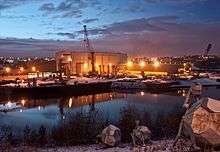
As with the coal-mining and shipbuilding, overseas competition has forced the closure of all of Sunderland's glass-making factories. Corning Glass Works, in Sunderland for 120 years, closed on 31 March 2007[150] and in January 2007, the Pyrex manufacturing site also closed,[151] bringing to an end commercial glass-making in the city. However, there has been a modest rejuvenation with the opening of the National Glass Centre which, amongst other things, provides international glass makers with working facilities and a shop to showcase their work, predominantly in the artistic rather than functional field.
Vaux Breweries was established in the town centre in the 1880s and for 110 years was a major employer. Following a series of consolidations in the British Brewing industry, however, the brewery was finally closed in July 1999.[152] Vaux in Sunderland and Wards in Sheffield had been part of the Vaux Group, but with the closure of both breweries it was re-branded The Swallow Group, concentrating on the hotel side of the business. This was subject to a successful take-over by Whitbread PLC in the autumn of 2000. [153] It is now a brownfield site and this is a derelict site in an urban area.
In 1855, John Candlish opened a bottleworks, producing glass bottles, with 6 sites at nearby Seaham and at Diamond Hall, Sunderland.
Education
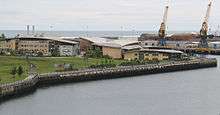
Sunderland Polytechnic was founded in 1969, becoming the University of Sunderland in 1992.[154] The institution currently has over 17,000 students.[155] The university is split into two campuses; the City Campus (site of the original Polytechnic) is just to the west of the city centre, as is the main university library and the main administrative buildings. The 'Award-Winning' St Peter's Riverside Campus is located on the north banks of the river Wear, next to the National Glass Centre and houses the School of Business, Law and Psychology, as well as Computing and Technology and The Media Centre.[156]
The University of Sunderland was named the top university in England for providing the best student experience by The Times Higher Education Supplement (THES) in 2006. Since 2001 Sunderland has been named the best new university in England by The Guardian and Government performance indicators showed Sunderland as the best new university in England for the quality, range and quantity of its research.[157]
Sunderland College is a further education establishment with five campuses located at the Bede centre on Durham Road, Shiney Row, Hylton, Doxford International Business Park and 'Phoenix House' in the city centre. It has over 14,000 students, and based on exam results is one of the most successful colleges.[158] St Peter's Sixth Form College, next to St Peter's Church and the University, opened in September 2008.[159] The college is a partnership between the three Sunderland North schools and City of Sunderland College.[160]
There are eighteen secondary schools in the Sunderland area, predominantly comprehensives. According to exam results, the most successful was St Robert of Newminster Catholic School, a coeducational secondary school and sixth form in Washington.[161] However, comprehensive schools also thrive, notably the Roman Catholic single-sex schools St. Anthony's (for girls) and St. Aidan's (for boys). Both continue to attain high exam results. There are seventy-six primary schools in Sunderland. According to the 'Value Added' measure, the most successful is Mill Hill Primary School, in Doxford Park.[162]
Politics
Sunderland voted for Brexit in the 2016 referendum on European Union membership by 61% of the vote; an unexpectedly high margin.[163][164]
The New Statesman[165] and The Daily Telegraph[166] have described Sunderland as the poster city for Brexit.
For decades, Sunderland has been an electoral stronghold of the Labour Party.
Sunderland is currently represented in the House of Commons in the Parliament of the United Kingdom by three Labour Members of Parliament; Bridget Phillipson, Julie Elliott and Sharon Hodgson.
| Houghton and Sunderland South | Sunderland Central | Washington and Sunderland West |
|---|---|---|
| Bridget Phillipson | Julie Elliott | Sharon Hodgson |
 |
 |
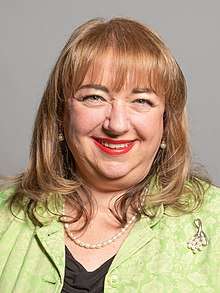 |
| Labour Party | Labour Party | Labour Party |
Transport
Metro

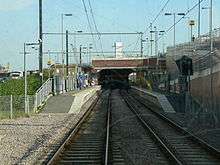
In May 2002 the Tyne and Wear Metro was extended to Sunderland in an official ceremony attended by The Queen, twenty-two years after it originally opened in Newcastle upon Tyne. The Green line now stretches deeper into South Tyneside and into Sunderland, incorporating Seaburn, Millfield, Pallion, as well as Sunderland's mainline railway station and stations at the Park Lane Transport Interchange and both campuses of the University of Sunderland before terminating at South Hylton. The trains run every 12–15 minutes (depending on time of day) and call at all stations. All-zones Metro tickets cost £5.20 for a daily and £22.40 for a weekly, as of October 2019.[167][168]
In March 2014 Metro owner Nexus proposed an extension of the network by the creation of an "on-street" tram link which would connect the city centre to South Shields to the north and Doxford Park to the west.[169]
Airport
Sunderland is served by Newcastle Airport, which is a 55-minute Metro ride from Sunderland city centre; there is a Metro train connecting with the airport every 12–15 minutes in both directions until about 11pm, Monday-Sunday.
Rail
National Rail
Sunderland station has 5 direct trains to London King's Cross on weekdays (5 on Saturday / 4 on Sunday), taking about 3 hours 30 minutes. Newcastle is a 30-minute Tyne & Wear Metro ride (see above) from Sunderland city centre, and has connecting services to London every half hour that take approximately 2 hours 45 minutes and also regular services to Edinburgh, Glasgow, Leeds, Manchester Piccadilly, Liverpool Lime Street, Birmingham and beyond.
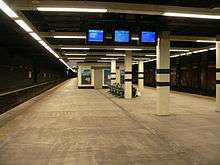
Sunderland station opened in 1879[170] but was completely redesigned to facilitate football teams and officials from countries who were drawn to play at Roker Park during England's hosting of the 1966 World Cup. It is situated on an underground level.[170] It was renovated in 2005, backed by the artistic team which designed the stations along the Wearside extension of the Tyne & Wear Metro in 2002.[171][172] It is situated on the Durham Coast Line served by direct Northern services to Newcastle, Hartlepool, Stockton and Middlesbrough, as well as further afield to Hexham, Carlisle and the Gateshead MetroCentre. These services run hourly in each direction, cut from half-hourly on 12 December 2005 (but towards Newcastle there is also the option of taking the Metro - see the Metro subsection above).
From 1998 to 2004, Northern Spirit and subsequently Arriva Trains Northern ran bihourly direct trains from Sunderland to Liverpool Lime Street via Durham, Darlington, York, Leeds and Manchester. The services were withdrawn due to a change of franchise which saw the First TransPennine Express route gain a franchise in its own right, distinct from the Regional Railways network which Arriva had inherited. Services now terminate at Newcastle, and a separate service also travels to Middlesbrough, but both only stretch as far as Manchester Airport.
In 2006, Grand Central announced plans to operate a direct service between Sunderland and London King's Cross via York, a service which had been stripped from Wearside twenty years earlier. A scaled-down service of one train each day began in December 2007, twelve months after the initial launch date, due to delays caused by restoring rolling stock and a protracted court case against GNER (which Grand Central won). The service increased to three departures daily each way on 1 March 2008, connecting a line which can run from Edinburgh to London. The service has proved so popular that daily fourth and fifth direct trains are now in operation.
When Virgin Trains East Coast were announced as the winners of the InterCity East Coast franchise in November 2014 their plans included a daily service from Sunderland to London Kings Cross that commenced in December 2015.[173]
Road
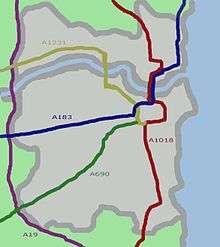
The fastest, largest and busiest road is the A19, which is a dual carriageway running north-to-south along the western edge of the urban area, crossing the River Wear at Hylton, and providing access north to the Tyne Tunnel, joining up with the A1 to Edinburgh, and south through Teesside, joining up with the A1M via the A168 at Thirsk, providing an entirely grade separated connection between Sunderland and the M1 motorway. The A19 originally ran through Sunderland city centre until the bypass was built in the 1970s; this route is now the A1018.
There are four main roads which support the city centre. The A690 Durham Road terminates in the city centre, and runs to Crook, County Durham via the city of Durham.
The A1231 (Sunderland Highway) begins in the city centre, crosses the Queen Alexandra Bridge and runs west through Washington to the A1. Most of this road is national speed limit dual carriageway.
The A1018 and A183 roads both start in the centre of South Shields and enter Sunderland from the north, before merging to cross the Wearmouth Bridge. The A1018 follows a direct route from Shields to Sunderland, the A183 follows the coast. After crossing the bridge, the A1018 follows a relatively straight path to the south of Sunderland where it merges with the A19. The A183 becomes Chester Road and heads west out of the city to the A1 at Chester-le-Street.
In Autumn 2007 the Southern Radial Route was opened. This is a bypass of the A1018 through Grangetown and Ryhope – a stretch that commonly suffered from congestion, especially during rush hour. The bypass starts just south of Ryhope, and runs parallel to the cliff tops into Hendon, largely avoiding residential areas.
Sunderland strategic transport corridor project, is an ongoing investment to the city's road infrastructure. The scheme will improve transport links around the city ensuring continuous dual carriageway between the A19 road and the port of Sunderland. The scheme also includes the building of a new wear bridge between Pallion on the south embankment and Castletown to the north.
Bus
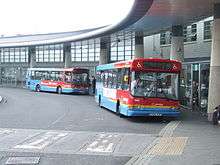
A multimillion-pound transport interchange at Park Lane was opened on 2 May 1999 by the then Brookside actor Michael Starke. With 750,000 passengers per year it is the busiest bus and coach station in Britain after Victoria Coach Station in Central London, and has won several awards for innovative design.[174] The majority of bus services in Sunderland are provided by Stagecoach in Sunderland and Go North East, with a handful of services provided by Arriva North East. Besides these, there are also inter state and inter city route buses mainly operated by National Express and Megabus . A new Metro station was built underneath the bus concourse to provide a direct interchange as part of the extension to South Hylton in 2002.
Cycle
There are a number of cycle routes that run through and around Sunderland. The National Cycle Network National Route 1 runs from Ryhope in the south, through the centre of the city, and then along the coast towards South Shields. Britain's most popular long-distance cycle route – The 'C2C' Sea to Sea Cycle Route – traditionally starts (or ends) when the cyclist dips their wheel in the sea on Roker beach. The 'W2W' 'Wear-to-Walney' route, and the 'Two-Rivers' (Tyne and Wear) route also terminate in Sunderland.
The Port
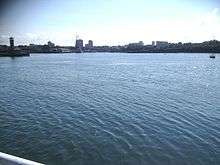
The Port of Sunderland is the second largest municipally owned port in the U.K.[175] The port offers a total of 17 quays[176] handling cargoes including forest products, non-ferrous metals, steel, aggregates and refined oil products, limestone, chemicals and maritime cranes.[175] It also handles offshore supply vessels and has ship repair and drydocking facilities.
The river berths are deepwater and tidal, while the South Docks are entered via a lock with an 18.9 m beam restriction.[177]
Culture
Dialect and accent
The dialect of Sunderland is known as Mackem, and contains a large amount of vocabulary and distinctive words and pronunciations not used in other parts of the United Kingdom. The Mackem dialect has much of its origins in the language spoken by the Anglo-Saxon population. Although the accent has so much in common with Geordie, the dialect spoken in Sunderland is quite distinctive from the dialect spoken in Newcastle.
A few Sunderland dialect words:
- Nee - No
- Bosh - Problem
- Marra - Mate
- Ha'way - Come on ( Not to be confused with Geordie's Howay)
- Knack - Hurt
- Git - Very (Used to emphasize something so 'very good' becomes 'git good')
- Claes - Clothes
Attractions
Notable attractions for visitors to Sunderland include the 14th century Hylton Castle and the beaches of Roker and Seaburn. The National Glass Centre opened in 1998, reflecting Sunderland's distinguished history of glass-making. Despite sustained support from the Arts Council the centre has struggled to meet visitor targets since it opened.[178]
Sunderland Museum and Winter Gardens, on Borough Road, was the first municipally funded museum in the country outside London.[91] It houses a comprehensive collection of the locally produced Sunderland Lustreware pottery. The City Library Arts Centre, on Fawcett Street, housed the Northern Gallery for Contemporary Art until the library was closed in January 2017. The library service was relocated to the Museum and Winter Gardens and the Gallery for Contemporary Art transferred to Sunderland University.[179]
The city possesses a number of public parks. Several of these are historic, including Mowbray Park, Roker Park and Barnes Park. In the early 2000s, Herrington Country Park was opened opposite Penshaw Monument. The city's parks have secured several awards for its commitment to preserving natural facilities, receiving the Britain in Bloom collective in 1993, 1997 and 2000.
Events
.jpg)
Each year on the last weekend in July, the city hosts the Sunderland International Airshow. It takes place primarily along the sea front at Roker and Seaburn.
Sunderland also hosts the free International Festival of Kites, Music and Dance, which attracts kite-makers from around the world to Northumbria Playing Fields, Washington.
Every year the city hosts a large Remembrance Day memorial service, the largest in the UK outside London in 2006.[180]
Sunderland's inaugural film festival took place in December 2003 at the Bonded Warehouse on Sunderland riverside, in spite of the lack of any cinema facilities in the city at that time, featuring the films of local and aspiring directors as well as reshowings of acclaimed works, such as Alan Bleasdale's The Monocled Mutineer, accompanied by analysis.[181] By the time of the second festival commencing on 21 January 2005, a new cinema multiplex had opened in Sunderland to provide a venue which allowed the festival to showcase over twenty films.
Sunderland celebrates an annual Restaurant week, where city centre restaurants provide some of the best plates at low costs.[182]
Literature and art
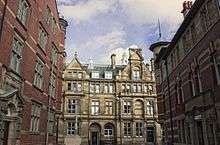
Lewis Carroll was a frequent visitor to the area. He wrote most of Jabberwocky at Whitburn as well as "The Walrus and the Carpenter".[183] Some parts of the area are also widely believed to be the inspiration for his Alice in Wonderland stories, such as Hylton Castle and Backhouse Park.[184] There is a statue to Carroll in Whitburn library. Lewis Carroll was also a visitor to the Rectory of Holy Trinity Church, Southwick; then a township independent of Sunderland. Carroll's connection with Sunderland, and the area's history, is documented in Bryan Talbot's 2007 graphic novel Alice in Sunderland.[185] More recently, Sunderland-born Terry Deary, writer of the series of Horrible Histories books, has achieved fame and success, and many others such as thriller writer Sheila Quigley, are following his lead.[186]
The Salford-born painter L. S. Lowry was a frequent visitor, staying in the Seaburn Hotel in Sunderland.[187] Many of his paintings of seascapes and shipbuilding are based on Wearside scenes. The Northern Gallery for Contemporary Art on Fawcett Street and Sunderland Museum and Winter Gardens showcase exhibitions and installations from up-and-coming and established artists alike, with the latter holding an extensive collection of Lowry. The National Glass Centre on Liberty Way also exhibits a number of glass sculptures.
Media, film and television
Sunderland has two local newspapers: the daily evening tabloid The Sunderland Echo, founded in 1873, and the Sunderland Star – a free newspaper.[188]
It also has its own commercial station, Sun FM, formerly an independent station but now owned by Nation Broadcasting who acquired the station from the UKRD Group, a student-led community radio station, Spark, and a hospital radio station – Radio Sunderland for Hospitals, and can receive other north-eastern independent radio stations Metro Radio, Greatest Hits North East, Capital North East and Smooth Radio North East. The current regional BBC radio station is BBC Radio Newcastle. The regional DAB multiplex for the Sunderland area is operated by Bauer DIGITAL RADIO LTD. – owned by Bauer Digital Radio plc. The city is covered by BBC North East and Cumbria and ITV's Tyne Tees franchise, which has a regional office in the University's Media Centre.[189]
Sunderland's first film company was established in 2008; and is known as "Tanner Films Ltd" and is based in the Sunniside area of the city. The companies first film, "King of the North" starring Angus MacFadyen and set in the Hetton-le-Hole area of the city; is currently under production.[190]
Music
Sunderland musicians that have gone on to reach international fame include Dave Stewart of the Eurythmics and all four members of Kenickie, whose vocalist Lauren Laverne later became known as a TV presenter. In recent years, the underground music scene in Sunderland has helped promote the likes of Frankie & the Heartstrings, The Futureheads, The Golden Virgins and Field Music.
Other Mackem musicians include punk rockers The Toy Dolls ("Nellie the Elephant", December 1984), oi! punk band Red Alert, punk band Leatherface, the lead singer of dance outfit Olive, Ruth Ann Boyle ("You're Not Alone", May 1997) and A Tribe of Toffs ("John Kettley is a Weatherman", December 1988).
In May 2005, Sunderland played host to BBC Radio 1's Big Weekend concert at Herrington Country Park, attended by 30,000 visitors and which featured Foo Fighters, Kasabian, KT Tunstall, Chemical Brothers and The Black Eyed Peas.[191][192]
The Sunderland Stadium of Light, home to Sunderland AFC, is recognised internationally as a major stadium concert venue. Headlining acts have included Oasis, Take That, Pink, Kings of Leon, Red Hot Chili Peppers, Coldplay, Bruce Springsteen and the E Street Band, Bon Jovi, Rihanna, One Direction, Foo Fighters and Beyonce. The Empire Theatre sometimes plays host to music acts. Independent, a city-centre nightclub/music venue, satisfies underground music lovers.
The Manor Quay' the students' union nightclub on St. Peter's Riverside at the University of Sunderland, has also hosted the Arctic Monkeys, Maxïmo Park, 911, the Levellers and Girls Aloud. In 2009, the club was taken into private ownership under the name Campus and hosted N-Dubz, Ocean Colour Scene, Little Boots, Gary Numan and Showaddywaddy but has since been returned to the university. The former students' union Wearmouth Hall hosted Voice of the Beehive, Manic Street Preachers, The Primitives and Radiohead before closing in 1992.
Since 2009, Sunderland: Live in the City has played host to a series of free and ticketed live music events throughout venues in the city centre. Sunderland also hosts the yearly Split Music Festival at Ashbrooke Cricket Club which was first celebrated in October 2009 and will return in 2010 with Maxïmo Park and The Futureheads headlining.
In 2013 local band Frankie and The Heartstrings opened a temporary pop up record store in the city, Pop Recs Ltd.[193] Initially only intended to remain open for a fortnight, the store remains open and has hosted live performances from acts including The Cribs, The Vaccines and The Charlatans.
Theatre
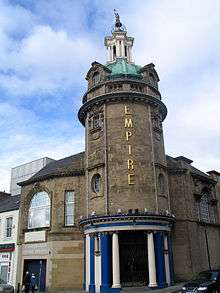
The Sunderland Empire Theatre opened in 1907 on High Street West in the city centre. It is the largest theatre in between Edinburgh and London, and completed a comprehensive refurbishment in 2004. Operated by international entertainment group Live Nation, the Empire is the only theatre between Glasgow and Leeds with sufficient capacity to accommodate large West End productions.[194] It is infamous for playing host to the final performance of British comic actor Sid James who died of a heart attack whilst on stage in 1976.[195]
The Royalty Theatre on Chester Road is the home to the amateur Royalty Theatre Group who also put on a number of low-budget productions throughout the year. Film producer David Parfitt belonged to this company before achieving worldwide fame and is now a patron of the theatre.[196]
The Sunniside area plays host to a number of smaller theatrical workshops and production houses, as well as the Theatre Restaurant, which combines a dining experience with a rolling programme of musical theatre.[197]
Twin towns and sister cities
Sunderland is twinned with:




Sunderland is the only city that is not a capital of country twinned with Washington, D.C., as it includes the town of Washington, the ancestral home of George Washington's family.[201]
Sport

The only "professional" sporting team in Sunderland is the football team, Sunderland A.F.C., and was elected to the Football League in 1890.[203] The club, which currently plays in EFL League One following consecutive relegations from the FA Premier League and the EFL Championship, is based at the 49,000 seat capacity Stadium of Light, which was opened in 1997.[204] Sunderland A.F.C also has the north-east's top women's football team, Sunderland A.F.C. Women, They currently play in the 3rd tier of English women's football – FA Women's National League North. Despite their financial struggles. Sunderland were league champions six times within the Football League's first half century, but have not achieved this accolade since 1936. Their other notable successes include FA Cup glory in 1937 and 1973 and winning the Division One title with a (then) English league record of 105 points in 1999.
Sunderland AFC's longest stadium occupancy so far was of Roker Park for 99 years beginning in 1898, with relocation taking place due to the stadium's confined location and the need to build an all-seater stadium. The initial relocation plan, announced in the early 1990s, had been for a stadium to be situated alongside the Nissan factory, but these were abandoned in favour of the Stadium of Light at Monkwearmouth on the site of a colliery on the banks of the River Wear that had closed at the end of 1993.[205] The city also has two non-league sides, Sunderland Ryhope Community Association F.C. of the Northern League Division Two and Sunderland West End FC of the Wearside League, who play at the Ford Quarry Complex.
Sunderland's amateur Rugby and Cricket clubs are both based in Ashbrooke.[206][207] The Ashbrooke ground was opened on 30 May 1887.
The Crowtree Leisure Centre has also played host to a number of important boxing matches and snooker championships including the 2003 Snooker World Trickshot and Premier League Final. In September 2005, BBC TV cameras captured international boxing bouts featuring local boxers David Dolan, Stuart Kennedy and Tony Jeffries. The latter became Sunderland's first Olympic medallist when he won a bronze medal in the light heavyweight boxing category for Great Britain and Northern Ireland at the 2008 Beijing Olympic Games.

On 18 April 2008, the Sunderland Aquatic Centre was opened. Constructed at a cost of £20 million, it is the only Olympic sized 50 m pool between Leeds and Edinburgh and has six diving boards, which stand at 1 m, 3 m and 5 m.[208]
Athletics is also a popular sport in the city, with Sunderland Harriers Athletics Club based at Silksworth Sports Complex. 800 m runner Gavin Massingham represented the club at the AAA Championships in 2005. On 25 June 2006, the first Great Women's Run took place along Sunderland's coastline. Among the field which lined up to start the race were Olympic silver medallists Sonia O'Sullivan of the Republic of Ireland and Gete Wami of Ethiopia, who eventually won the race. The race quickly became an annual fixture in the city's sporting schedule, with races in 2007 and 2008. In 2009, the race will be relaunched as the Great North 10K Run, allowing male competitors to take part for the first time, on 12 July.[209]
Notable residents
See also
- Sunderland's Boxing Day dip
- The North Dock Tufa
- List of important dates in the history of Sunderland
- The New Monkey
References
- UK Census (2011). "Local Area Report – Sunderland Built-up area (1119884905)". Nomis. Office for National Statistics. Retrieved 24 February 2018.
- "Roker (Whitburn South) Beach". UK Beach Guide. 2017. Retrieved 18 August 2017.
- "Seaburn Beach (Whitburn North)". UK Beach Guide. 2017. Retrieved 18 August 2017.
- "Hendon South Beach (Sunderland)". UK Beach Guide. 2018. Retrieved 2 January 2018.
- "Old Sunderland History". englandsnortheast.co.uk. Retrieved 25 March 2018.
- Bosworth, Joseph (21 March 2010). Toller, Thomas Northcote; Christ, Sean; Tichý, Ondřej (eds.). "Sundor-land (supplementary)". An Anglo-Saxon Dictionary Online. Faculty of Arts, Charles University in Prague. Retrieved 22 December 2018.
- Bosworth, Joseph (21 March 2010). Toller, Thomas Northcote; Christ, Sean; Tichý, Ondřej (eds.). "Sundor-land". An Anglo-Saxon Dictionary Online. Faculty of Arts, Charles University in Prague. Retrieved 22 December 2018.
- "The Mackem Wordhunt". BBC. 2005. Retrieved 3 April 2008.
- "The word Mackem origins". Phrases.org website. 2005. Retrieved 3 April 2008.
- "Sunderland Mackem Origin". englandsnortheast.co.uk. 2016. Retrieved 19 August 2017.
- "Mackem". Seagull City. 2017. Retrieved 19 August 2017.
- "Sunderland : 'Mackems'". England's North East. Retrieved 22 December 2018.
- Glen Lyndon Dodds (2001). A History of Sunderland (2nd ed.). p. 5. ISBN 0-9525122-6-2.
- Glen Lyndon Dodds (2001). A History of Sunderland (2nd ed.). p. 6. ISBN 0-9525122-6-2.
- "Brewery may hold Roman answers". BBC News. 2 September 2003. Retrieved 22 July 2009.
- "Museum and Winter Gardens – Look At Glass". Sunderland Echo. 2005. Archived from the original on 13 May 2008. Retrieved 3 April 2008.
- "Sunderland History". Weardaleway website. 2005. Archived from the original on 31 January 2009. Retrieved 3 April 2008.
- H. J. White, The Codex Amiatinus and its Birthplace, in: Studia Biblica et Ecclesiasctica (Oxford 1890), Vol. II, p. 273.
- "Libraries". Catholic Encyclopedia. Retrieved 23 January 2007.
- "Academic – The Venerable Bede". Bede's World museum. 2008. Archived from the original on 4 June 2003. Retrieved 3 April 2008.
- "Book of the Month, Bede Wrings on the Calendar". University of Glasgow. 2001. Retrieved 3 April 2008.
- "Origins of Bishopwearmouth". Archived from the original on 27 September 2007. Retrieved 23 January 2007.
- "Ryhope Village". Wearsideonline website. 2008. Archived from the original on 16 March 2008. Retrieved 3 April 2008.
- "What's in a name?". Sunderland Echo. Retrieved 17 January 2007.
- David Simpson (1991). "The North East England History Pages". The Millennium History of North East England. Retrieved 3 April 2008.
- "Newcastle Coal". England's North East. Retrieved 27 August 2019.
- Pevsner, Nikolaus; Williamson, Elizabeth (1983). The Buildings of England: County Durham (2nd ed.). London: Penguin.
- "Sunderland Ship Building". This is Sunderland website. 2008. Archived from the original on 14 August 2007. Retrieved 3 April 2008.
- Tim Lambert (2008). "A Brief History of Sunderland". Retrieved 3 April 2008.
- "North East History, Early Coal Mining". The Northern Echo. 2003. Archived from the original on 27 September 2007. Retrieved 3 April 2008.
- "Did you know?". North East History website. 2003. Retrieved 3 April 2008.
- Burnett, James (1830). The history of the town and port of Sunderland, and the parishes of Bishopwearmouth and Monkwearmouth. Sunderland: J. S. Burnett. p. 44.
- History.com Staff (2009). "English civil wars". history.com. A+E Networks. Retrieved 29 July 2015.
- Dodds, Derek (20 October 2005). Northumbia… (Battlefield Britain). England: Leo Cooper Ltd (20 Oct 2005). p. 139. ISBN 1844151492.
- "A History of Sunderland (second edition, 2001), Glen Lyndon Dodds, pp. 46–48".
- "Offerton, site of Civil War skirmish - Details". twsitelines.info. Retrieved 19 August 2016.
- Sykes, John (1833). Local Records: Or, Historical Register of Remarkable Events, which Have Occurred in Northumberland and Durham, Newcastle Upon Tyne, and Berwick Upon Tweed (vol. 1). Newcaste: J. Sykes. p. 114.
- Marr, J. A. "A History of Shipbuilding on the Wear". The Sunderland Site. Retrieved 3 September 2019.
- "Port History". Port of Sunderland. Retrieved 26 August 2019.
- Jones, Robin (2014). Lighthouses of the North East Coast. Wellington, Somerset: Halsgrove.
- Skempton, A. W. (1974). "A History of the Steam Dredger, 1797–1830". Transactions of the Newcomen Society. 47 (1): 97–116.
- Davis, Ralph (2012). The Rise of the English Shipping Industry in the Seventeenth and Eighteenth Centuries (2nd ed.). Oxford University Press. p. 62.
- The New Encyclopaedia Britannica: Micropaedia. 1983.
- Johnson, Michael; Potts, Graham (2013). The Architecture of Sunderland 1700-1914. Stroud, Gloucs.: The History Press.
- "Glassmaking on Wearside". BBC. Retrieved 5 September 2019.
- "Sunderland Industries". England's North East. Retrieved 5 September 2019.
- Historic England. "Websters Ropery (Grade II listing) (1207121)". National Heritage List for England. Retrieved 27 August 2019.
- "Photo: blue plaque". Geograph. Retrieved 26 August 2019.
- Shegog, Eric. "Sunderland Minster". City of Sunderland College. Archived from the original on 27 June 2008. Retrieved 9 December 2006.
- "Short History of Sunderland". www.hodstw.org.uk. Archived from the original on 18 September 2015. Retrieved 3 June 2016.
- "Sunderland Wearmouth Bridge". Wearside Onliine. Archived from the original on 27 November 2011. Retrieved 24 September 2006.
- "Sunderland Under Attack" (PDF). Limestone Landscapes. Retrieved 26 August 2019.
- "Defending the Port". Victoria County History. Retrieved 26 August 2019.
- "Sunderland : 'Old Sunderland'". Wearside History. Retrieved 16 October 2016.
- "BBC Diary of an Epidemic". BBC website. 2003. Retrieved 3 April 2008.
- Diary of an Epidemic (Cholera), BBC Radio 4,
- "Who was Jack Crawford?" (PDF). Sunderland Council. 2005. Archived from the original (PDF) on 11 October 2007. Retrieved 3 April 2008.
- "Burning Questions". The Northern Echo. 2003. Retrieved 3 April 2008.
- "Hetton Colliery Railway". Engineering Timelines. Retrieved 6 September 2019.
- "Armstrong, Addison & Co, Timber Merchants, Sunderland". The National Archives. Retrieved 16 September 2019.
- "Sunderland North Dock, site of". Engineering Timelines. Retrieved 31 August 2019.
- "Wearmouth Colliery". Durham Mining Museum. Retrieved 31 August 2019.
- "Wearmouth Colliery" (PDF). AditNow: the site for mine explorers and mining historians. Retrieved 31 August 2019.
- "On the waterfront: First sea link with the docks". Sunderland Echo. Retrieved 31 August 2019.
- "Sunderland South Docks". Engineering Timelines. Retrieved 31 August 2019.
- "Nos 1 & 2 Warehouses, North Hudson Docks, Sunderland, Tyne & Wear". Historic England. Retrieved 31 August 2019.
- "Colliery Railways: Londonderry Seaham & Sunderland 1854/55". Durham Records Online. Retrieved 31 August 2019.
- Historic England. "Swing-bridge, lock and walls of north end of Dock (1207097)". National Heritage List for England. Retrieved 17 September 2019.
- Historic England. "Swing-bridge at east side with ashlar walls (1279892)". National Heritage List for England. Retrieved 17 September 2019.
- Chance, James Frederick (2018). A History of the Firm of Chance Brothers & Co. Sheffield: Society of Glass Manufacturers. p. 182.
- British Islands Pilot, vol. VII. Washington DC: Government Printing Office. p. 299.
- "Tyne and Wear HER(2874): Sunderland, South Dock (Hudson Dock) - Details". SiteLines. Retrieved 31 August 2019.
- Map, 1894
- Map detail, 1894
- Historic England. "Wave Basin Battery adjacent to old South Pier (1207135)". National Heritage List for England. Retrieved 16 September 2019.
- "Shipbuilding on the Wear: Part 2" (PDF). Sunderland Council. Retrieved 5 September 2019.
- "Shipbuilding on the Wear: Part 1" (PDF). Sunderland Council. Retrieved 5 September 2019.
- Clarke, Joseph Finbar (1997). Building Ships on the North-East Coast. Bewick Press. p. 93.
- "Sunderland, Hudson Dock, George Clark Engine Works - Details". SiteLines. Retrieved 7 September 2019.
- "Sunderland's Victoria Hall Stampede". North Country Web. Archived from the original on 8 January 2007. Retrieved 27 January 2007.
- "Victims of the Victoria Hall Calamity". Genuki. Retrieved 27 January 2007.
- "The Victoria Hall Disaster 1883" (PDF). City of Sunderland Library. Archived from the original (PDF) on 11 July 2007. Retrieved 27 January 2007.
- Carol Roberton (2000). "Give them a fitting memorial". Sunderland Echo. Retrieved 3 April 2008.
- "The Victoria Hall Disaster of 1883". BBC h2g2. Retrieved 26 May 2007.
- "Toy Tragedy Children Honoured". BBC News. 12 May 2002. Retrieved 27 January 2007.
- Talbot, Bryan (2007). Alice in Sunderland: An Entertainment. London: Jonathon Cape. pp. 58–60. ISBN 0-224-08076-8.
- "Yorkshire Film Archive -". Northeastfilmarchive.com. Retrieved 4 August 2017.
- "SINE Project: Structure details for Queen Alexandra Bridge". University of Newcastle upon Tyne. Archived from the original on 25 January 2009. Retrieved 12 October 2006.
- Henderson, Tony (29 May 2014). "Monkwearmouth Station Museum in Sunderland hosts First World War poster exhibition". The Journal. Retrieved 3 June 2016.
- Map, with dates
- Chronicle, Evening (1 January 2012). "Ten interesting facts about Sunderland". Retrieved 4 August 2017.
- "The Leader-Post - Google News Archive Search". news.google.com. Retrieved 4 August 2017.
- Kevin Clark (2006). "A Good Little Runner". Sunderland Echo. Retrieved 3 April 2008.
- "The history of Nissan's Sunderland factory". The Daily telegraph. London. Retrieved 3 June 2016.
- Laura White (2004). "Centre will be a glass act again". Retrieved 3 April 2008.
- "Sir Tom gets own campus!". Sunderland Echo. 2002. Archived from the original on 1 February 2009. Retrieved 3 April 2008.
- "Have your say on Vaux site". Sunderland Echo. 2003. Retrieved 3 April 2008.
- "A History of Sunderland". localhistories.org.
- "Saint that nice – our own patron". Sunderland Echo. 2005. Retrieved 3 April 2008.
- Archived 4 July 2011 at the Wayback Machine
- Archived 1 September 2010 at the Wayback Machine
- Archived 1 September 2010 at the Wayback Machine
- "Rare images recall wartime blitz". BBC News. 12 April 2005. Retrieved 18 January 2007.
- Sarah Stoner (2006). "Roker's 'cathedral of arts and crafts'". Sunderland Echo. Retrieved 3 April 2008.
- Church of St Mary and Attached Railings, Sunderland from British listed buildings, retrieved 12 December 2015
- UK Census (2011). "Local Area Report – Sunderland Local Authority (1946157068)". Nomis. Office for National Statistics. Retrieved 24 February 2018.
- Monkwearmouth was settled shortly after the unification of the kingdoms of Bernicia and Deira into Northumbria in AD 654.
- In AD 866, Vikings invaded southern Northumbria (formerly Deira), creating the kingdom of Jorvik (York). During this period, Jorvik made numerous incursions into Bernicia (the part of Northumbria north of the Tees), and largely subjugated the Anglian kingdom.
- Saint Cuthbert's Land, between the Tyne and the Tees, became a distinct political entity in AD 883. Wessex united with Northumbria and defeated Jorvik in AD 927, creating the Kingdom of England.
- Durham was founded in AD 995.
- Durham ceased to be a county palatine in 1836.
- "STILL TIME TO SEE SUNDERLAND SHINE". Sunderland Council. 2007. Archived from the original on 24 January 2009. Retrieved 3 April 2008.
- "GREEN BELT REVIEW STAGE 1 – CORE STRATEGY GROWTH OPTIONS STAGE, MARCH 2016" (PDF). www.sunderland.gov.uk.
- "Sunderland climate information". Met Office. Retrieved 23 December 2017.
- "2001 Census – Fact Cards for wards in the City of Sunderland". Sunderland city Council. Archived from the original on 27 September 2007. Retrieved 26 January 2007.
- "Sunderland 2001 Census Statistics" (PDF). Archived from the original (PDF) on 11 July 2007. Retrieved 18 January 2007.
- The Thornholme ward no longer existed in the United Kingdom Census 2011
- Neighbourhood Statistics. "Check Browser Settings". Neighbourhood.statistics.gov.uk. Retrieved 3 June 2016.
- "Archived copy". Archived from the original on 30 September 2018. Retrieved 16 June 2018.CS1 maint: archived copy as title (link)
- "Millfield - UK Census Data 2011". UK Census Data. Retrieved 14 November 2015.
- Good Stuff IT Services. "Redhill - UK Census Data 2011". Ukcensusdata.com. Retrieved 3 June 2016.
- "Sunderland - UK Census Data 2011". UK Census Data. Retrieved 14 November 2015.
- Services, Good Stuff IT. "North East - UK Census Data 2011". UK Census Data.
- "RCDHN". rcdhn.org.uk. rcdhn.org.uk. Retrieved 29 January 2017.
- Services, Good Stuff IT. "Sunderland - UK Census Data 2011". UK Census Data. Retrieved 6 October 2017.
- "Sunderland Jews". www.seligman.org.il. Retrieved 27 June 2019.
- Seligman, Jon. "Sunderland Jews". www.seligman.org.il. Retrieved 5 October 2017.
- "Archived copy". Archived from the original on 12 September 2007. Retrieved 1 June 2007.CS1 maint: archived copy as title (link)
- "BBC - Wear - Jewish community gradually fades". BBC News. 12 August 2009. Retrieved 3 June 2016.
- "Sunderland - UK Census Data 2011". UK Census Data. Retrieved 14 November 2015.
- "TOP OF THE WORLD". Sunderland City Council. 20 January 2005. Archived from the original on 12 March 2007. Retrieved 9 December 2006.
- "Sunniside". Sunderland arc. 6 January 2009. Archived from the original on 26 February 2009. Retrieved 10 March 2009.
- "Sunderland Unitary Development Plan". 6 January 2009. Archived from the original on 30 March 2009. Retrieved 10 March 2009.
- "Vaux Site FAQ". 4 March 2008. Archived from the original on 26 February 2009. Retrieved 10 March 2009.
- "Vaux Site Opportunity". 4 March 2008. Archived from the original on 26 February 2009. Retrieved 10 March 2009.
- "Images of Sunderland's new £11.8million square". Sunderland Echo. 16 October 2013. Retrieved 9 August 2014.
- "Stadium Park Development". 1 January 2006. Archived from the original on 25 October 2007. Retrieved 10 March 2009.
- "New Bridge". 10 March 2008. Archived from the original on 18 November 2009. Retrieved 10 March 2009.
- "Next step in road to iconic Wear bridge". 1 December 2008. Retrieved 10 March 2009.
- "Gorve Site". 1 January 2006. Archived from the original on 26 February 2009. Retrieved 10 March 2009.
- "Port of Sunderland". 1 January 2006. Archived from the original on 27 February 2009. Retrieved 10 March 2009.
- "History of Shipbuilding in the North East". BBC. Retrieved 18 January 2007.
- "History of shipbuilding on Wearside". Bbc.co.uk. Retrieved 4 August 2017.
- "SINE Project: Structure details for South Dock: Hudson Dock". University of Newcastle upon Tyne. Archived from the original on 16 June 2006. Retrieved 22 November 2006.
- "The clipper ship Torrens". Sunderlandecho.com. Retrieved 4 August 2017.
- "BBC - Nation on Film - Shipbuilding - Background". Bbc.co.uk. Retrieved 4 August 2017.
- "LOCAL STUDIES CENTRE FACT SHEET NUMBER 10:Shipbuilding on the Wear: Part 1". Sunderland Public Library Service. Archived from the original on 2 September 2012. Retrieved 27 August 2013.
- "Rise and Fall of Coal Mining". North East England History. Retrieved 18 January 2007.
- "Exhibition digs into Sunderland's mining history". Sunderlandecho.com. Archived from the original on 11 September 2017. Retrieved 4 August 2017.
- "End of an era as glass firm sets closure date". The Northern Echo. 16 January 2007. Retrieved 18 January 2007.
- "Energy costs close glass factory". BBC News. 17 January 2007. Retrieved 18 January 2007.
- Journal, The. "Painful Anniversary for Vaux Brewery, Sunderland - journallive Administrator". The Journal. Retrieved 3 June 2016.
- Buckingham, Lisa; Editor, City (22 November 1999). "Whitbread in £550m bid for Swallow". The Guardian. ISSN 0261-3077. Retrieved 15 June 2020.CS1 maint: extra text: authors list (link)
- "University history". Sunderland University. 2 January 2008. Retrieved 3 April 2008.
- "Facts, Figures, Accolades, the University's vision". Sunderland University. 2 January 2008. Archived from the original on 18 March 2008. Retrieved 3 April 2008.
- "The University". Sunderland University, Our Campuses. 2 January 2008. Retrieved 3 April 2008.
- "Awards and Accolades 2007/8". Sunderland University website. 2 January 2008. Archived from the original on 27 April 2008. Retrieved 3 April 2008.
- "City of Sunderland College". Archived from the original on 7 December 2006. Retrieved 18 January 2007.
- "Work begins on £6 m campus college". BBC News. 2 January 2008. Retrieved 3 January 2008.
- "St Peter's Sixth Form College". Archived from the original on 27 January 2008. Retrieved 3 January 2008.
- "Secondary school league tables in Sunderland". BBC News. 23 April 2013. Retrieved 30 April 2017.
- "Primary Schools in Sunderland League Table". BBC News. Retrieved 18 January 2007.
- Lindsay, Kali (31 January 2020). "How the world reacted when Sunderland voted to leave the European Union". nechronicle. Retrieved 6 March 2020.
- Freytas-Tamura, Kimiko de (27 June 2016). "Pro-'Brexit' City of Sunderland Glad to Poke Establishment in the Eye". The New York Times. ISSN 0362-4331. Retrieved 6 March 2020.
- "How Sunderland became a poster child for Brexit". www.newstatesman.com. Retrieved 6 March 2020.
- Wallace, Tim (6 December 2019). "Special report: Sunderland aiming to be the 'poster city for Brexit'". The Telegraph. ISSN 0307-1235. Retrieved 6 March 2020.
- https://www.nexus.org.uk/metro-day-ticket
- https://www.nexus.org.uk/metro-season-ticket
- "New South Tyneside Metro and tram link-up plans revealed". Shields Gazette. 27 March 2014. Retrieved 3 June 2016.
- "Sunderland Central Station". Disused Stations. Retrieved 3 June 2016.
- "New look arriving". Sunderland Echo. 27 April 2005. Retrieved 3 March 2008.
- "New rail service launch delayed". BBC News. 21 November 2006. Retrieved 22 November 2006.
- "Stagecoach-Virgin company awarded InterCity East Coast rail franchise - Stagecoach Group". Stagecoach.com. 27 November 2014. Retrieved 3 June 2016.
- "Did you know? Sunderland facts". Sunderland Echo News. 21 November 2006. Archived from the original on 2 August 2007. Retrieved 22 November 2006.
- "Port of Sunderland". Port of Sunderland. Retrieved 6 July 2014.
- "Port of Sunderland - Port Map". Port of Sunderland. Archived from the original on 14 August 2013. Retrieved 6 July 2014.
- "Port of Sunderland - South Docks". Port of Sunderland. Archived from the original on 14 August 2013. Retrieved 6 July 2014.
- "Another new head for Glass Centre". BBC News. 2 July 2004. Retrieved 18 January 2007.
- "Closure date set for Sunderland's City Library". Sunderlandecho.com. Retrieved 4 August 2017.
- "North honours fallen war heroes". BBC News. 12 November 2006. Retrieved 17 January 2007.
- Hattenstone, Simon (5 December 2003). "The show must go on". The Guardian. London. Retrieved 1 April 2010.
- https://sunderlandvibe.com/sunderland-restaurant-week-2020-what-to-expect/
- "The Walrus and the Carpenter". Sunderland and East Durham History. Retrieved 18 January 2007.
- Alice in Sunderland, Bryan Talbot, 2007, ISBN 978-1-59307-673-3
- Robertson, Ross (27 March 2007). "News focus: Alice in Pictureland". Sunderland Echo. Archived from the original on 2 April 2007. Retrieved 29 March 2007.
- "Grandmother has write stuff". BBC News. 6 May 2003. Retrieved 28 December 2007.
- "Masters of Art". Sunderland Echo. Archived from the original on 31 December 2006. Retrieved 18 January 2007.
- "Newspaper Report for the publication: Sunderland Star". The Newspaper Society. Archived from the original on 14 July 2007. Retrieved 6 March 2007.
- "Julia Barthram". ITV Tyne Tees. Archived from the original on 8 March 2007. Retrieved 6 March 2007.
- "$6million film deal for North East murder film". Sunderlandecho.com. Retrieved 4 August 2017.
- "Radio 1's Big Weekend: Penshaw Monument, Herrington Park, Sunderland". BBC Radio 1. Retrieved 26 February 2007.
- "Local boys shine at Sunderland's Big Weekend". BBC News. Retrieved 26 February 2007.
- Youngs, Ian (9 October 2013). "Frankie and the Heartstrings: Record shop boys". BBC News. Retrieved 3 June 2016.
- "The Sunderland Empire Theatre". Sunderland City Council. Archived from the original on 22 December 2006. Retrieved 18 January 2007.
- "1989: Ghostly tale". Sunderlandecho.com. Archived from the original on 18 September 2012. Retrieved 4 August 2017.
- "Restaurant puts entertainment on menu". Sunderland Echo. 17 August 2007. Retrieved 3 June 2016.
- "Harbin is linking up with Sunderland". Harbin News Web. Archived from the original on 1 March 2014. Retrieved 8 August 2013.
- "China opens a window on Sunderland – Local". Sunderland Echo. 18 May 2009. Archived from the original on 21 May 2009. Retrieved 16 March 2011.
- "British towns twinned with French towns [via WaybackMachine.com]". Archant Community Media Ltd. Archived from the original on 5 July 2013. Retrieved 20 July 2013.
- "DC Sister Cities - os". os.dc.gov. Retrieved 16 July 2018.
- "Sunderland City Council: Further Information on Essen". Sunderland.gov.uk. Archived from the original on 22 April 2016. Retrieved 3 June 2016.
- Sunderland : the Complete Record / Rob Mason. Breedon Books, 2005. pp 16-17
- "SAFC Previous Grounds / History / Previous Grounds". SAFC website. 2 January 2008. Retrieved 3 April 2008.
- "Sunderland Cricket Club". SAFC website. 2 January 2008. Retrieved 3 April 2008.
- "SAFC Previous Grounds". vega.sund.ac.uk website. 2 January 2008. Archived from the original on 7 May 2006. Retrieved 3 April 2008.
- "A Very Warm Welcome to Sunderland RFC. The Home of Sunderland Rugby Union". sunderlandrufc.com website. 2 January 2008. Archived from the original on 10 March 2008. Retrieved 3 April 2008.
- "Sunderland Echo Olympic splash-out spectacular". Sunderland Echo.
- "Great North 10K moves". BBC News. Retrieved 28 June 2013.
External links
| Wikisource has original text related to this article: |



